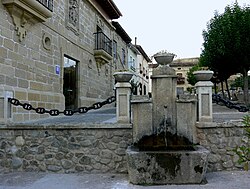Villalobar de Rioja | |
|---|---|
 Plaza de España. Fountain and Hotel El Palacete. | |
Location within La Rioja. | |
| Coordinates: 42°29′31″N2°57′43″W / 42.49194°N 2.96194°W | |
| Country | |
| Autonomous community | |
| Comarca | Santo Domingo de la Calzada |
| Government | |
| • Mayor | Álvaro Tecedor Rotaeche (PP) |
| Area | |
• Total | 10.94 km2 (4.22 sq mi) |
| Elevation | 585 m (1,919 ft) |
| Population (2024) [1] | |
• Total | 73 |
| Demonym | villalobarense |
| Postal code | 26256 |
| Website | www |
You can help expand this article with text translated from the corresponding article in Spanish. (August 2011)Click [show] for important translation instructions.
|
Villalobar de Rioja is a municipality of the Autonomous region of La Rioja (Spain), with no more than 100 inhabitants. [2] It is located in a privileged location between Santo Domingo de la Calzada and Haro.


